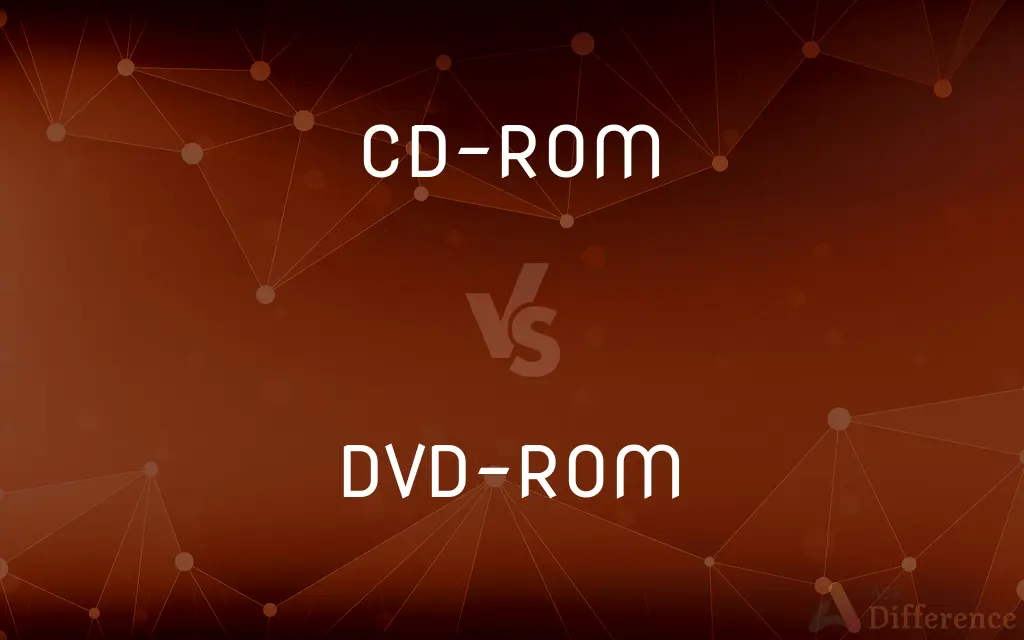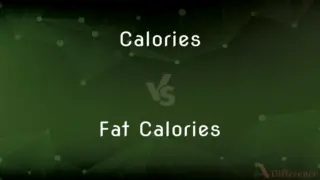CD-ROM vs. DVD-ROM — What's the Difference?
By Maham Liaqat & Urooj Arif — Published on March 2, 2024
CD-ROM stores up to 700MB and primarily holds software and audio files, while DVD-ROM can store 4.7GB to 17GB, suited for high-quality video and larger software.

Difference Between CD-ROM and DVD-ROM
Table of Contents
ADVERTISEMENT
Key Differences
CD-ROM, introduced in the mid-1980s, was revolutionary for storing data much beyond the capacity of floppy disks, making it a popular medium for software distribution. DVD-ROM, which emerged in the late 1990s, expanded on this capacity significantly, allowing for the storage of full-length movies in digital format.
The storage capacity of a standard CD-ROM is around 700MB, which suited the needs of audio storage and smaller software applications for many years. In contrast, a single-layer DVD-ROM can hold 4.7GB of data, making it ideal for larger applications, games, and high-definition video content.
CD-ROMs operate at slower read speeds compared to DVD-ROMs. This speed difference affects how quickly data can be accessed and transferred, making DVD-ROMs more efficient for larger files and multimedia content.
The technology behind CD-ROMs relies on a 780 nm wavelength laser to read the disc, whereas DVD-ROMs use a 650 nm laser, which allows for tighter data packing and hence more storage capacity.
Compatibility is another difference; DVD-ROM drives can usually read CD-ROMs, providing a backward compatibility feature. However, CD-ROM drives cannot read DVD-ROM discs due to the different technologies and data encoding methods used.
ADVERTISEMENT
Comparison Chart
Introduced
Mid-1980s
Late 1990s
Storage Capacity
Up to 700MB
4.7GB to 17GB
Read Speed
Slower
Faster
Laser Technology
780 nm wavelength
650 nm wavelength
Main Use
Audio, software
High-quality video, larger software
Compare with Definitions
CD-ROM
Primarily used for audio and small software applications.
I found an old CD-ROM with my favorite computer game.
DVD-ROM
Can store up to 17GB of data, depending on the disc type.
This DVD-ROM can hold an entire software suite.
CD-ROM
Accessed using a laser that reads the disc.
My computer's CD-ROM drive is not reading discs properly anymore.
DVD-ROM
Backward compatible with CD-ROMs in most drives.
My DVD-ROM drive can also read CDs.
CD-ROM
A compact disc used to store data that cannot be modified.
The software installation was provided on a CD-ROM.
DVD-ROM
A digital versatile disc used for storing large amounts of data.
The movie is available on a DVD-ROM.
CD-ROM
Offers a maximum storage capacity of around 700MB.
The entire album fits on a single CD-ROM.
DVD-ROM
Uses a more precise laser technology than CD-ROMs.
DVD-ROMs require a specific type of laser to read the densely packed data.
CD-ROM
Requires a CD-ROM drive for access.
You'll need a CD-ROM drive to install this software.
DVD-ROM
Ideal for high-definition video and large applications.
Most high-quality films are distributed on DVD-ROM.
CD-ROM
A compact disc that functions as read-only memory.
CD-ROM
A compact disk that is used with a computer (rather than with an audio system); a large amount of digital information can be stored and accessed but it cannot be altered by the user.
CD-ROM
A compact disk that is used with a computer (rather than with an audio system); a large amount of digital information can be stored and accessed but it cannot be altered by the user
Common Curiosities
Are DVD-ROMs compatible with CD-ROM drives?
No, CD-ROM drives cannot read DVD-ROMs due to different laser technologies and storage formats.
What is the main difference between CD-ROM and DVD-ROM?
The main difference is storage capacity: CD-ROMs hold up to 700MB, while DVD-ROMs store 4.7GB to 17GB.
Can DVD-ROMs play audio files like CD-ROMs?
Yes, DVD-ROMs can store and play audio files, offering much larger storage for higher quality or more files.
What are the typical uses for CD-ROMs today?
CD-ROMs are typically used for smaller software installations, audio CDs, and data archiving.
What is the significance of laser wavelength in CD-ROM and DVD-ROM technology?
The laser wavelength determines the density at which data can be stored; shorter wavelengths in DVD-ROMs allow for greater storage capacity.
How has the usage of CD-ROMs and DVD-ROMs changed over the years?
With the advent of digital downloads and streaming, the use of physical storage like CD-ROMs and DVD-ROMs has decreased.
Why do DVD-ROMs have more storage capacity than CD-ROMs?
DVD-ROMs use a shorter wavelength laser, allowing for tighter data packing and more storage capacity.
Can CD-ROMs be rewritten or erased?
Standard CD-ROMs cannot be rewritten or erased; they are read-only memory.
Can I use a CD-ROM to store video content effectively?
While possible, CD-ROMs are limited by storage capacity, making them less ideal for high-quality video content compared to DVD-ROMs.
What speed do DVD-ROM drives operate at compared to CD-ROM drives?
DVD-ROM drives typically operate at higher speeds, allowing for faster data access and transfer.
How much data can a dual-layer DVD-ROM hold?
A dual-layer DVD-ROM can hold up to 8.5GB of data.
Are all DVD-ROM drives able to read CD-ROMs?
Most modern DVD-ROM drives can read CD-ROMs, offering backward compatibility.
Can DVD-ROMs be used for software installation?
Yes, DVD-ROMs are commonly used for installing larger software applications that exceed the storage capacity of CD-ROMs.
Is there a quality difference in audio and video between CD-ROMs and DVD-ROMs?
DVD-ROMs can store higher quality audio and video due to their larger storage capacity.
What advancements have succeeded CD-ROM and DVD-ROM technologies?
Blu-ray discs and digital storage solutions like USB flash drives and cloud storage have succeeded CD-ROM and DVD-ROM technologies for higher capacity and convenience.
Share Your Discovery

Previous Comparison
Holland vs. Netherland
Next Comparison
Calories vs. Fat CaloriesAuthor Spotlight
Written by
Maham LiaqatCo-written by
Urooj ArifUrooj is a skilled content writer at Ask Difference, known for her exceptional ability to simplify complex topics into engaging and informative content. With a passion for research and a flair for clear, concise writing, she consistently delivers articles that resonate with our diverse audience.
















































